Breaking News: Discover the Shocking Truth Behind the “Death Cloak” That Terrified Drunkards More Than Any Hangover!
Originating from 16th century England, the Drunkards Cloak was a peculiar form of public punishment designed specifically for those guilty of excessive drinking. The punishment involved placing a hollow barrel on the torso of the offender, with openings for the head and arms to protrude, leading them to be paraded around town in a spectacle of humiliation. This was not merely an embarrassing experience; it served as a deterrent against public drunkenness and a reminder of societal norms surrounding alcohol consumption.
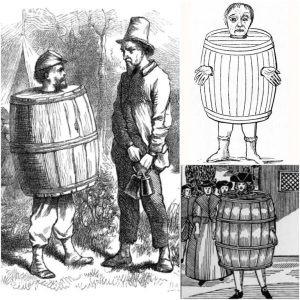
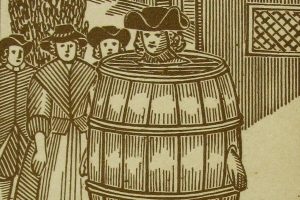
Public Domain The Drunkards Cloak emerged in England as a means of punishment but swiftly became known across Europe and America.
Imagine waking up after a wild night out, holding your aching head, feeling nauseous, and burdened with countless regrets weighing on your conscience. You’ve just experienced a hangover, a phenomenon that many would regard as sufficient punishment for overindulgence. However, for the English of the 16th century, it was not enough. Instead, they devised a much harsher punishment for repeat offenders: the infamous Drunkards Cloak.
This punishment was quite straightforward. Those captured for frequent offenses while inebriated were forced to wear an empty beer barrel designed with a hole on top for their head and occasionally equipped with openings for their arms as well (if luck was on their side). After being fitted with this ludicrous apparatus, they would be marched through the community, subjected to ridicule from their fellow townspeople.
Alcohol consumption has long been woven into the fabric of English history, steeped in tradition and social interaction. However, the Drunkards Cloak embodied a stark resistance to this inherent cultural practice, unactionable law tailored specifically to counteract public drunkenness.
Exploring the significance of drinking culture in the northeast of England, it’s essential to note that the Drunkards Cloak is also referred to as the Newcastle Cloak. This name hints at its possible origins in Newcastle upon Tyne, a city long associated with spirited gatherings and jovial drinking.
Information regarding this punishment device is somewhat scarce, and while it is widely acknowledged that it was employed in several cities across Europe, its precise beginnings remain speculative. Tour guide Alex Lyon from the Clink Prison Museum in London remarked, Although we are confident that it was used in various cities, the first recorded use in England traces back to Newcastle upon Tyne during the Puritan era around 1650. However, we cannot definitively claim it was invented there.
So, why Newcastle? Historian Dan Jackson explained this aspect to HistoryExtra, suggesting that the city has cultivated a longstanding reputation steeped in alcohol culture. It’s a bit of a cliché,” he remarked, “but drinking culture is deeply rooted in Newcastle; the city claims to have been one of the first in England to produce beer. Additionally, its hospitality was famously summed up in the 18th century, suggesting that it meant to be generous to the point of ‘killing someone with kindness,’ or rather, inviting them out for drinks.
The truth is that, just like today, the residents of Newcastle turned to alcohol centuries ago to unwind after grueling days of labor. At the time, this labor often involved grueling work in coal mines and shipyards rather than the standard office job we see today.
As Jackson stated, It was almost inevitable that people would drink when they had downtime from their strenuous work obligations. Coal miners were notoriously known for their drinking habits, as were shipyard workers, particularly sailors who might return home with money in their pockets after months at sea.
Naturally, when a significant portion of the populace indulges excessively, it becomes inevitable that some individuals will overindulge. In response, authorities sought ways to counteract this rampant alcohol-related behavior.
Fearing the adverse effects of unrestrained revelry, the English Parliament began seeking methods to regulate alcohol consumption throughout the realm. To curb drunkenness, the Ale Houses Act of 1551 was passed, formalizing public intoxication as a civil offense.
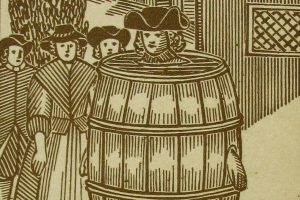
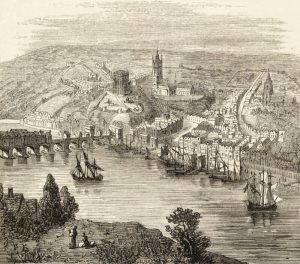
Universal History Archive/Universal Images Group via Getty Images An illustration of a man wearing the Drunkards Cloak, a form of public shaming punishments originating in England.
According to VinePair, anyone arrested for public drunkenness faced a small fine of five shillings, but repeat offenders found guilty of public drunkenness suffered a far more severe and humiliating fate: the Drunkards Cloak.
This cloak was, in its simplest form, a hollow, open beer barrel with a head hole. Occasionally, but not always, it included armholes for the drunken wearer’s convenience. As noted in Mark P. Donnelly and Daniel Diehl’s book *Big Book of Pain: Torture & Punishment Through History*, this peculiar punitive device might have been conceived under the reign of King James I of England, who supposedly enjoyed devising bizarre punishments tailored specifically to various crimes.
However, it was during Oliver Cromwell’s governance that the Drunkards Cloak truly gained traction. Cromwell, soldier and statesman, served as Lord Protector of England, Scotland, and Ireland from 1653 to 1658. Historically, Cromwell held a dislike for merriment, dancing, and, most notably, drinking.
Despite its eccentricity, the Drunkards Cloak quickly spread beyond the borders of England. In Germany, it was known as the Schandmantel, or “cloak of shame,” while in Denmark it was referred to as the Spanish Cloak. Moreover, it wasn’t long before this unique punishment crossed the ocean and made its way to America.
The Use of the Barrel-Shirt in the United States
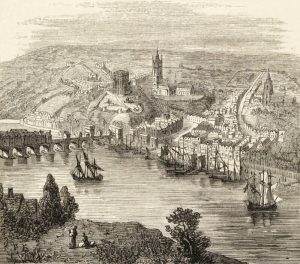
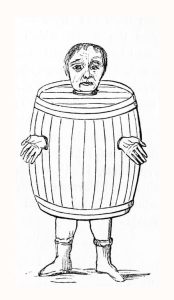
Wikimedia Commons The barrel-shirt, the American version of the Drunkards Cloak.
While the Drunkards Cloak found its roots in Europe, it reached the United States in the 19th century. According to Alice Morse Earle’s *Curious Punishments of Bygone Days*, the Cloak was used sparingly to discipline soldiers during the Civil War era.
In one vivid account gathered by Earle, a hapless culprit was confined in an oak structure, head fitting into a hole cut at one end of the barrel, walking around despondently, resembling a half-born chicken. In another instance from 1863, a volunteer infantry lieutenant from Maine punished two of his company members for drunkenness by locking them in barrels, parading them through town with the sign reading, I wear this for being drunk for four hours.
I dont think theyll be drinking again anytime soon, the lieutenant commented with a sense of finality.
In one surprising twist, an officer recalled how one of his soldiers thanked him years later for enforcing the infamous barrel-shirt punishment, stating that he had not touched a drop of liquor since that day.
Additionally, during the Civil War, soldiers could also be forced to don the Drunkards Cloak for offenses like theft. Earle documented instances in which men were required to wear both a barrel and a sign proclaiming them as thieves.
Perhaps the most fascinating aspect of the Drunkards Cloak, nonetheless, lies in its surprising efficacy despite being relatively innocuous. Compared to other methods of punishment or torture, the Drunkards Cloak was rather humane, relying more on the power of public examination and shame than on physical pain. Surprisingly, it often proved effective in modifying behavior and discouraging repeat offenses.
However, not all subjects were deterred by the humiliating spectacle. Although the Drunkards Cloak may have fallen out of favor, drinking culture remains a prevalent and cherished tradition in places like Newcastle.
Alcohol has always played a significant role in the culture of Northumbria, for better or worse, anthropologist Dan Jackson explained. It has always served as a social lubricant, and Newcastle is still regarded as a party city today. This outlook traces back centuries, and its hard to shake off that cultural identity.
Leave a Reply